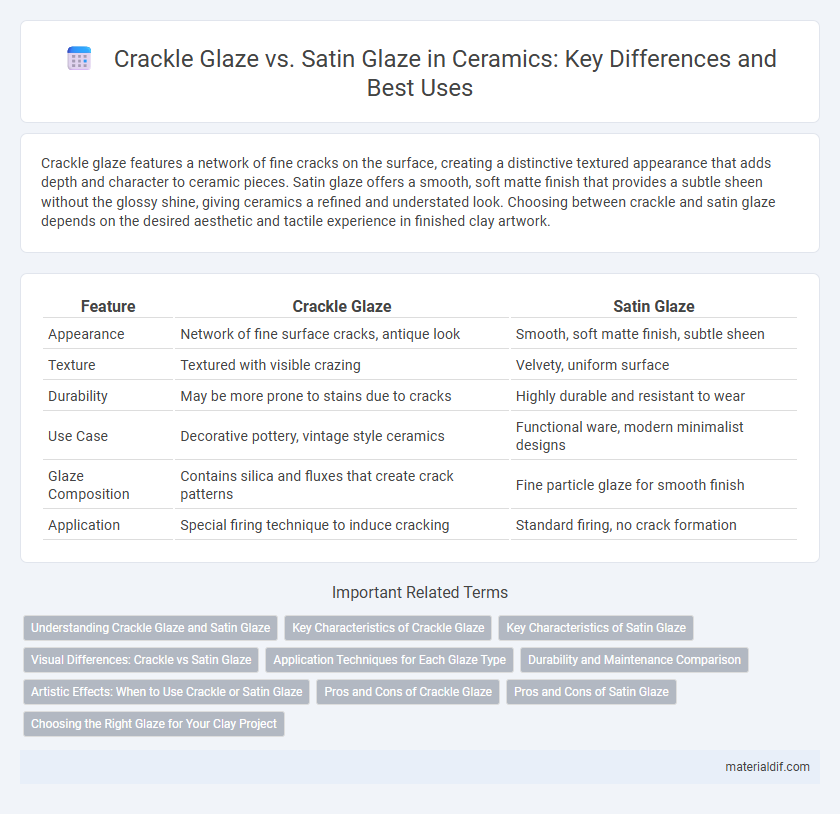Crackle glaze features a network of fine cracks on the surface, creating a distinctive textured appearance that adds depth and character to ceramic pieces. Satin glaze offers a smooth, soft matte finish that provides a subtle sheen without the glossy shine, giving ceramics a refined and understated look. Choosing between crackle and satin glaze depends on the desired aesthetic and tactile experience in finished clay artwork.
Table of Comparison
| Feature | Crackle Glaze | Satin Glaze |
|---|---|---|
| Appearance | Network of fine surface cracks, antique look | Smooth, soft matte finish, subtle sheen |
| Texture | Textured with visible crazing | Velvety, uniform surface |
| Durability | May be more prone to stains due to cracks | Highly durable and resistant to wear |
| Use Case | Decorative pottery, vintage style ceramics | Functional ware, modern minimalist designs |
| Glaze Composition | Contains silica and fluxes that create crack patterns | Fine particle glaze for smooth finish |
| Application | Special firing technique to induce cracking | Standard firing, no crack formation |
Understanding Crackle Glaze and Satin Glaze
Crackle glaze features intentional network-like fractures on the surface, created by differences in cooling rates between the glaze and clay body, enhancing texture and visual depth. Satin glaze offers a smooth, soft sheen with a matte finish that highlights form without high gloss, achieved through fine particle distribution in the glaze mixture. Understanding these distinct glazing techniques helps artists choose the ideal finish for aesthetic and functional qualities in ceramic pieces.
Key Characteristics of Crackle Glaze
Crackle glaze is distinguished by its network of fine, intentional surface cracks that create a textured, antique appearance, often enhancing the visual depth and character of ceramic pieces. This type of glaze emphasizes surface imperfection as a key aesthetic trait, contrasting with satin glaze, which offers a smooth, matte finish with a soft sheen and uniform texture. Crackle glaze results from controlled cooling and glaze composition, allowing the ceramic artist to achieve a distinctive aged or weathered effect valued in both functional pottery and decorative art.
Key Characteristics of Satin Glaze
Satin glaze on clay exhibits a smooth, matte finish that enhances surface texture without the high shine of crackle glaze. It provides subtle luster and a soft tactile feel, making it ideal for functional pottery requiring a gentle, non-reflective appearance. Unlike crackle glaze, satin glaze resists surface crazing and offers more durability in everyday use.
Visual Differences: Crackle vs Satin Glaze
Crackle glaze features a network of fine, deliberate cracks on the surface, creating a textured and antique appearance that highlights the glaze's depth and character. Satin glaze, by contrast, provides a smooth, matte finish with a soft sheen that diffuses light evenly, offering a subtle and elegant look without visible surface fissures. The visual impact of crackle glaze is more dynamic and rustic, while satin glaze emphasizes understated sophistication and tactile smoothness.
Application Techniques for Each Glaze Type
Crackle glaze requires precise application techniques such as controlled thickness and rapid drying to enhance the characteristic crazing effect, often achieved through layering with a brush or dipping methods. Satin glaze demands an even, smooth application with careful sanding between coats to produce its signature soft, matte finish. Both glazes benefit from specific firing schedules that influence texture and surface quality in ceramic works.
Durability and Maintenance Comparison
Crackle glaze features a network of fine surface cracks that create a distinctive textured appearance but can be more susceptible to moisture infiltration and staining, impacting its durability over time. Satin glaze offers a smooth, matte finish that resists scratches and stains more effectively, making it easier to clean and maintain in high-usage environments. Choosing satin glaze enhances longevity and reduces upkeep requirements compared to crackle glaze, especially in functional clayware like dinnerware or tiles.
Artistic Effects: When to Use Crackle or Satin Glaze
Crackle glaze offers a distinctive network of fine cracks that enhance texture and add a vintage or rustic aesthetic, ideal for pieces aiming to evoke an aged or weathered appearance. Satin glaze provides a smooth, matte finish that softens colors and highlights subtle surface details, making it suitable for contemporary or minimalist designs where understated elegance is desired. Choosing between crackle and satin glaze depends on the desired artistic effect, with crackle glaze emphasizing texture and character, while satin glaze emphasizes softness and refined simplicity.
Pros and Cons of Crackle Glaze
Crackle glaze offers a unique, artistic texture characterized by fine network patterns that enhance the visual interest of ceramic pieces but may compromise durability due to potential water absorption and staining risks. Its aesthetic appeal is favored for decorative pottery and art ceramics where surface design is prioritized over functional use. However, compared to satin glaze, crackle glaze typically requires more careful maintenance and sealing to prevent moisture damage.
Pros and Cons of Satin Glaze
Satin glaze offers a smooth, matte finish that enhances the natural texture of clay while providing moderate durability and resistance to scratches compared to the glossy, reflective surface of crackle glaze. It tends to better conceal fingerprints and minor imperfections, making it ideal for functional pottery and everyday use, though it may lack the visual depth and unique crackled patterns valued in artistic pieces. Satin glaze requires careful application to avoid unevenness and generally demands more frequent cleaning to maintain its soft luster.
Choosing the Right Glaze for Your Clay Project
Crackle glaze creates a network of fine cracks on the surface, adding unique texture and visual interest to ceramic pieces, ideal for decorative projects that emphasize rustic or vintage aesthetics. Satin glaze offers a smooth, soft sheen without the high gloss, enhancing the tactile quality of the clay while providing a subtle, elegant finish suited for functional pottery and sculptural work. Selecting the right glaze depends on the desired visual effect, durability requirements, and the clay body compatibility with each glaze type.
Crackle Glaze vs Satin Glaze Infographic

 materialdif.com
materialdif.com